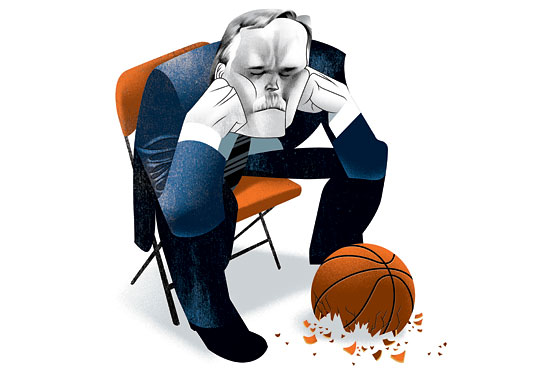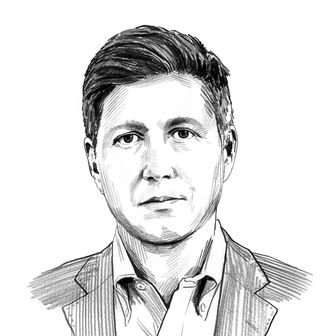
Almost four years ago, Mike D’Antoni was the prettiest girl at the ball. During the middle part of the aughts, the then–Phoenix Suns coach revolutionized the NBA game with his vaunted “Seven Seconds or Less” style of offense, inspired by his time playing in Europe (where he was so popular a preteen Kobe Bryant wore his jersey number) and immortalized in writer Jack McCallum’sfamous book of the same name. His style energized a game that had become clunky and graceless; after a decade of Charles Oakley clones punching anyone who even approached the lane, D’Antoni’s freewheeling offensive game—led by Steve Nash, Joe Johnson, Shawn Marion, and Amar’e Stoudemire at the peak of their powers—made the NBA giddy, delirious fun again. It was basketball the way it was supposed to be played.
But like many exhilarating insurgents, D’Antoni’s Suns were too beautiful to survive. Players got too expensive and left town (Johnson, Marion) or got injured (Stoudemire), postseasson series turned just the wrong way (the famed 2007 series against the San Antonio Spurs that might have been fixed by disgraced referee Tim Donaghy), and management grew too impatient for a title and brought in Shaquille O’Neal, who wouldn’t have been a worse fit for D’Antoni’s system were he an arthritic arthropod. After the 2008 season, D’Antoni and the Suns were divorcing. And everybody wanted him.
The team that coveted him most was the Chicago Bulls, which had the type of athletes who would excel under D’Antoni, like Ben Gordon, Joakim Noah, Kirk Hinrich, and (especially) Luol Deng. The Bulls went after D’Antoni hard, and at one point, he agreed to a deal, because “he said he didn’t want to coach the Knicks,” Bulls owner Jerry Reinsdorf claimed. But, at the eleventh hour, Jim Dolan and Donnie Walsh swooped in with an overwhelming offer: a four-year package worth a total of $24 million (the third-highest contract in the NBA at the time), a hand-in-hand personnel deal with Walsh, and, most intriguingly, loads of upcoming salary-cap space meant to draw free agent LeBron James, who would obviously want to come to New York when his contract with Cleveland was done. The Bulls, for their part, were not pleased D’Antoni went back on his word. “It’s not the end of the world,” Reinsdorf said. “But it is somewhat rude.”
A month later, the Bulls would draft Derrick Rose with the first overall pick. LeBron, in characteristically quiet and low-key fashion, chose the Miami Heat. Four years later, the Bulls and Heat are the two best teams in basketball, and the Knicks are the NBA’s biggest disappointment, with fans and media screaming for D’Antoni’s head. (A report in the Daily said D’Antoni could get fired as early as Super Bowl weekend, after this magazine went to press. Sketchily sourced as the story was, the situation is so volatile right now that Dolan could start swinging the ax at any moment.) So much for the prettiest girl at the ball.
Could all this have been avoided? Is it all D’Antoni’s fault? Was it a mistake to bring him here in the first place? Can the D’Antoni plan be salvaged? The Knicks are unquestionably a disaster right now. When the team’s senior vice-president Glen Grunwald realized that a Chris Paul trade was highly unlikely and instead signed center Tyson Chandler, the Knicks frontcourt of Chandler, Stoudemire, and Carmelo Anthony became, for a moment, the envy of all basketball. Chandler, fresh off a championship with the Dallas Mavericks, told me, “Do I think this team is a championship team? You can’t just push a button and make a championship. But yes. Yes, I do.”
Right now, it’s not even a competent team. The Knicks were an anemic 8-14 heading into last weekend, Stoudemire looks frighteningly old all of a sudden, and the team’s point-guard play—thanks largely to the decision to cut Chauncey Billups to make room for Chandler—is alternately incompetent and self-immolating. The Knicks can’t shoot, they can’t pass, they can’t drive the lane, and they can’t guard. You can make a strong argument that, in terms of hype, presumed talent, and payroll expenditures, they’re the biggest letdown and waste of resources this town has seen since Mayor Bloomberg’s Olympic bid, or maybe the 1992 Bobby Bonilla–Vince Coleman Mets.
The most frustrating part about this is not so much that the team is so awful; after all, over the past decade of Isiah Thomas and the Years of Fixing What Isiah Thomas Broke, Knicks fans have seen plenty of bad basketball. The problem is that this is what the Knicks were building toward. All that salary-cap cleansing, all the hours spent watching someone named Sergio Rodriguez dribble aimlessly around, all the losses … this is what we got for it. We had been told there would be cake.
Perhaps inevitably, the blame has fallen on D’Antoni, who, after all, is 111-157 as Knicks coach. He’s in the last year of his contract, was brought in by Walsh, has never been known to be close to Dolan, and, by the way, the offense he supposedly has so much expertise in has been malfunctioning all year. From the start, D’Antoni’s offense-first obsessiveness felt like an odd fit in New York, which has always fetishized hard-nosed players over finesse ones, your Lawrence Taylors over your Danilo Gallinaris. But if the Knicks can’t average more than a point per possession—and they’re not doing that, for the first time in more than a decade—what is the point, exactly, of having D’Antoni around anyway?
The criticism of D’Antoni essentially seems to come down to “He’s not willing to adjust his system to fit his players,” which is another way of saying, “Hey, it’s not our fault your system requires a point guard and we gave all ours away: Figure it out.” The one constant of D’Antoni’s success has been a functioning floor general, from Nash in Phoenix to Raymond Felton and Billups last season. But it is worth pointing out that D’Antoni hasn’t always been as inflexible as he’s been painted. Jared Jeffries, a defensive specialist and the polar opposite of a “D’Antoni” player, has been one of the few constant rotation players since D’Antoni got here. D’Antoni is more malleable than he’s been given credit for. As he himself put it, “I’d play Satan himself if I could win.”
The problem isn’t necessarily D’Antoni refusing to alter his system; the problem is the Knicks’ inability to find, or hold on to, players that work within it. Walsh spent two years not only clearing out Isiah flotsam but also bringing in D’Antoni-type players like Gallinari, Felton, and even Russian center Timofey Mozgov. When Stoudemire was added to that team last season, the Knicks, after some growing pains, turned for a while into the D’Antoni team everyone was waiting for, becoming one of the NBA’s highest-scoring teams and securing a winning record for the first time in D’Antoni’s tenure. It was starting to work. And then Carmelo arrived.
Just when D’Antoni had installed his offense and found the right players to run it, the Knicks traded them all away for a player who is decidedly the opposite of a D’Antoni player: an isolation specialist whose belief in his own skills far outpaces his interest in working with anyone else. Carmelo has been the team’s best player since he came over here, but he’s never meshed with this roster, particularly because all the three-point shooters whom D’Antoni would use to open up the lane for him and Stoudemire (Gallinari, Chandler, Felton) were sent away to bring him here. It’s still too early to call the trade a “mistake”—even as Gallinari and Mozgov help lead the Nuggets to one of the best records in the NBA—but it certainly has proved a catastrophe for D’Antoni. Carmelo is an unmovable part you build around, the sort of offensive talent (and defensive liability) you bring in players to complement. And if you’re bringing in players to work with Carmelo, you’re not fitting D’Antoni’s offense.
The problem with D’Antoni, as with many an innovator before him, is that once he lost the ability to influence management (that is to say, Walsh)—and you can argue that D’Antoni and Walsh both lost that ability with the Carmelo trade, which many sources claimed was done against Walsh’s wishes by Dolan—he became irrelevant. If D’Antoni can’t get players who work in his system (and now, with Walsh gone and Dolan back unequivocally running things, he can’t), there really isn’t much reason for him to be here.
There is a short window for D’Antoni to survive, riding mostly on 33-year-old Baron Davis returning from his injuries to play the point the way a D’Antoni offense requires in time to make a playoff run (and, of course, Carmelo altering his inherent nature). But considering the truncated season and the lack of practice time available, that seems highly unlikely. Whether it comes after this season or as early as this week, the end for D’Antoni appears nigh.
At this point, you have to wonder if it was ever going to work out for D’Antoni here. His system is built on specific-use players, not superstars, but New York is a superstar town. This now seems obvious, and sad, for all parties involved. Perhaps the Knicks will find the coach who can make Anthony and Stoudemire and Chandler and Unnamed Future Point Guard work. Perhaps D’Antoni will find another situation to rebuild his reputation. Maybe, all told, he should have gone to Chicago in the first place. One suspects, as the losses mount, and the boos cascade, and the “We Want Phil!” chants rain down upon him, he wonders about that himself.
E-mail: will.leitch@nymag.com.
